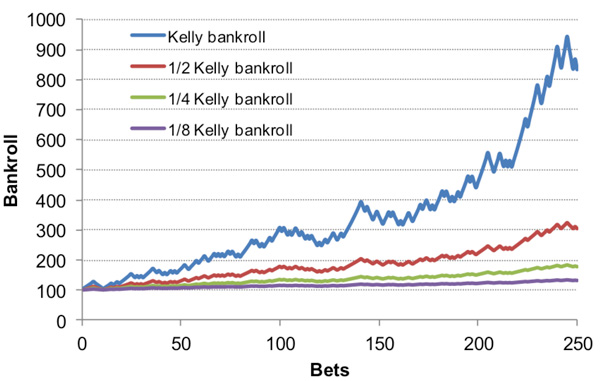Kelly Growth Criterion
The Kelly Criterion is a scientific gambling method using a formula for bet sizing that mathematically calculates the proper position size for placing a bet based on the odds. The Kelly bet size is calculated by optimizing the projected value of the wealth logarithm, which is equivalent to maximizing the expected geometric growth rate of the capital being wagered. The Kelly Criterion is a formula used to bet a preset fraction of an account. It can seem counterintuitive in real time.
Find many great new & used options and get the best deals for The Kelly Capital Growth Investment Criterion: Theory and Practice by Maclean (2010, Hardcover) at the best online prices at eBay! Free shipping for many products! The Kelly criterion is maximally aggressive — it seeks to increase capital at the maximum rate possible. Professional gamblers typically take a less aggressive approach, and generally will not bet more than about 2.5% of their bankroll on any wager. In this case that would be $25.00.
The Kelly formula is : Kelly % = W – (1-W)/R where:

- Kelly % = percentage of capital to be put into a single trade.
- W = Historical winning percentage of a trading system.
- R = Historical Average Win/Loss ratio.
We develop a general framework to apply the Kelly criterion to the stock market data, and consequently, to portfolio optimization. Under few conditions, using Monte Carlo simulations with different scenarios we prove that the Kelly criterion beats any other approach in many aspects. In particular, it maximizes the expected growth rate and the median of the terminal wealth. The Kelly Criterion is the brilliant summation of a betting strategy first discovered by Information Theorist John Kelly. Kelly came up with a betting system which optimizes bankroll growth based upon known odds and a definite payout.
Here are the statistics traders need to calculate the Kelly Criterion:
- You can use the data from your trading records or backtesting data for your system for calculating the Kelly Criterion.
- Your system’s winning probability is your “W”.
- Your system’s win/loss ratio is your “R”.
- These numbers are the input into Kelly’s equation above for calculating bet size.
- The Kelly percentage is what the equation returns.
For an even money bet, the Kelly criterion computes the wager size percentage by multiplying the percent chance to win by two, then subtracting one. So, for a bet with a 70% chance to win (or 0.7 probability), doubling 0.7 equates 1.4, from which you subtract 1, leaving 0.4 as your optimal wager size: 40% of available funds. – Wikipedia
Review The Kelly Capital Growth Investment Criterion: Theory and Practice
by LEONARD C. MACLEAN, EDWARD O. THORP, WILLIAM T. ZIEMBA
Description
This book contains the definitive treatment of fortune’s formula, also known as the Kelly capital growth criterion. This strategy aims to amplify long-run wealth by maximizing period by the period expected utility with a logarithmic utility function. Generally, the strategy can be risky when used short-term, but when the number of bets is increased, the bettor’s wealth can be bigger in comparison to using other strategies.
Kelly Criterion Pdf
This book is encouraged to graduate and postdoctoral students, academics, and researchers. Aside from that, it is also recommended to professional traders interested in betting strategies. With that in mind, the book has many jargons and technical concepts that would need prior knowledge in order to be understood. This book is not for the common readers, though the book already indicates that.
On the good side, this book expounds on the strategy Kelly Criterion as it is applied to investing. The book is divided into six parts and subdivided into chapters, allowing the reader to pick a particular topic they want. Many chapters are discussing various topics, which assures that the Kelly Criterion is discussed here very well.
About the Author

Kelly Criterion Proof
LEONARD C. MACLEAN is Professor Emeritus of Rowe School of Business at Dalhousie University. He has written various publications and has been awarded the Rowe Business School Researcher of the Year Award in 2014. He received his MA and Ph.D. from Dalhousie University.
EDWARD O. THORP is most popular in the finance industry in his book Beat the Dealer, published in 1962. It was the first book to prove that blackjack can be beaten through card counting mathematically. He is regarded as among the best hedge fund managers globally.
Kelly Growth Criterion Definition
WILLIAM T. ZIEMBA is Alumni Professor of Financial Modeling and Stochastic Optimization and Professor Emeritus of the Sauder School of Business at the University of British Columbia from 1968-2004. He earned his Ph.D. from the University of California, Berkeley.
Table of Contents
Kelly Criterion For Stocks
Preface
List of Contributors
Acknowledgments
Pictures
Part I: The Early Ideas and Contributions
Part II: Classic Papers and Theories
Part III: The Relationship of Kelly Optimization to Asset Allocation
Part IV: Critics and Assessing the Good and Bad Properties of Kelly
Part V: Utility Foundations
Part VI: Evidence of the Use of Kelly Type Strategies by the Great Investors and Others
Bibliography
Author Index
Subject Index